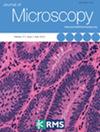用于干涉散射显微镜的空间光调制。
IF 1.5
4区 工程技术
Q3 MICROSCOPY
引用次数: 0
摘要
干涉散射(iSCAT)显微镜可对单个分子和小纳米粒子进行高速和无标记检测。在这里,我们应用点扩散函数工程,利用空间光调制对 iSCAT 图像进行自适应控制。利用这种方法,我们展示了改进的动态空间滤波、实时背景减除、聚焦控制和基于样品方向的信号调制。本文章由计算机程序翻译,如有差异,请以英文原文为准。

Spatial light modulation for interferometric scattering microscopy
Interferometric scattering (iSCAT) microscopy enables high-speed and label-free detection of individual molecules and small nanoparticles. Here we apply point spread function engineering to provide adaptive control of iSCAT images using spatial light modulation. With this approach, we demonstrate improved dynamic spatial filtering, real-time background subtraction, focus control, and signal modulation based on sample orientation.
求助全文
通过发布文献求助,成功后即可免费获取论文全文。
去求助
来源期刊

Journal of microscopy
工程技术-显微镜技术
CiteScore
4.30
自引率
5.00%
发文量
83
审稿时长
1 months
期刊介绍:
The Journal of Microscopy is the oldest journal dedicated to the science of microscopy and the only peer-reviewed publication of the Royal Microscopical Society. It publishes papers that report on the very latest developments in microscopy such as advances in microscopy techniques or novel areas of application. The Journal does not seek to publish routine applications of microscopy or specimen preparation even though the submission may otherwise have a high scientific merit.
The scope covers research in the physical and biological sciences and covers imaging methods using light, electrons, X-rays and other radiations as well as atomic force and near field techniques. Interdisciplinary research is welcome. Papers pertaining to microscopy are also welcomed on optical theory, spectroscopy, novel specimen preparation and manipulation methods and image recording, processing and analysis including dynamic analysis of living specimens.
Publication types include full papers, hot topic fast tracked communications and review articles. Authors considering submitting a review article should contact the editorial office first.
 求助内容:
求助内容: 应助结果提醒方式:
应助结果提醒方式:


